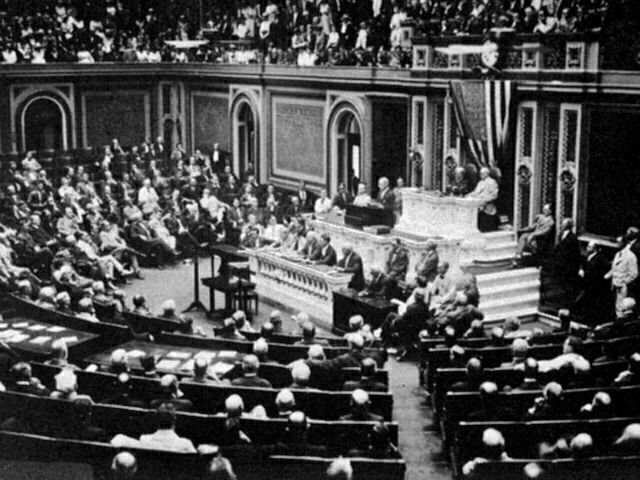 * Editor’s Note: On April 12 at 12 p.m., historians come together at the National Constitution Center to commemorate the 100th anniversary of the United States’ entry into World War I. Learn more and get tickets.
* Editor’s Note: On April 12 at 12 p.m., historians come together at the National Constitution Center to commemorate the 100th anniversary of the United States’ entry into World War I. Learn more and get tickets.
On April 6, 1917, Congress approved President Woodrow Wilson’s declaration of war against Germany by a vote of 82-6 in the Senate and 373-50 in the House, thus plunging the nation into World War I. On December 7, war was declared on Austria-Hungary as well. The “Great War” had begun in 1914, and the United States had done all it could to remain neutral. But in the end, the Central Powers arguably gave the U.S. no choice but to get involved.
In 1914, after the outbreak of war in Europe, President Wilson declared that the U.S. would operate under a non-interventionist policy. This policy worked very well for the American economy, helping pull the country out of a recession. Major banks like J.P. Morgan took the opportunity to provide financial assistance to Britain and France in the form of large loans. Industrial production of exports doubled from 1913-1917, as both sides had trade relations with the U.S. that continued throughout the war.
But neither the Allied nor Central Powers allowed goods to flow freely to the other side. The British set up an embargo on the Germans and attempted to seize American merchant ships going to Germany. On the other side, Germany violated international law by sinking U.S. ships headed to Britain or France. The sinking of the Lusitania, as well as the Sussex, caused an uproar in the states. Wilson, still trying to avoid war, forced Germany to enter into the Sussex pledge, in which they promised to allow American crew members to abandon ship before it was sunk.
The war was a major issue in the 1916 election. Wilson’s reelection platform was anchored by the fact that he had kept the U.S. out of war. His opponent, former Supreme Court Justice Charles Evan Hughes, wanted a policy of “preparedness,” fearing that the U.S. would be dragged into the war one way or another. The election was hotly contested and most people expected that the result would be extremely close. On election night, the story goes, Hughes went to bed believing he was President, as he was ahead in California at that time. In the morning, a reporter called Hughes for a comment. Someone else answered and said, “The President is asleep.” The reporter responded, “When he wakes up, tell him he’s not President.” Wilson had pulled out a victory in California, giving him a 277-254 Electoral College win.
After the election, despite Wilson running as the peace candidate, it became more and more likely that the U.S. would enter the war. The Germans violated the Sussex pledge and continued their strategy of unrestricted submarine warfare, thinking that the continual sinking of American ships would force the British to surrender quickly. But this led Wilson to ask Congress for permission to arm merchant ships going to Britain, as well as to sever all diplomatic ties with Germany. Congress ultimately filibustered the request, but regardless, the relationship had soured with the Germans.
But this was not the tipping point. That would ultimately be the Zimmerman Telegram. In February 1917, British intelligence picked up a telegram from German Foreign Minister Arthur Zimmerman intended for Mexico, hoping to entice them to attack the United States. The British forwarded this to Wilson, and the press got wind of it a week later. The telegram was published, and public opinion flipped in favor of entering the war.
In order to raise an army, the U.S. passed the Selective Service Act in 1917, which authorized a draft that added 2.8 million people to the armed forces. These forces arrived in France in late 1917 and early 1918—perfect timing, as both sides had been worn down by the four-year-old war. Americans helped fight against the German Spring Offensive, and then finished them off in the Hundred Days Offensive. An armistice was signed on November 11, 1918.
Chris Calabrese is an intern at the National Constitution Center. He is also a recent graduate of St. Joseph’s University.
Recent Historical Posts on Constitution Daily
What really killed the first President to die in office?
Is Aaron Burr really the father of the filibuster?
How to end a filibuster: World War I and the origin of the cloture rule







